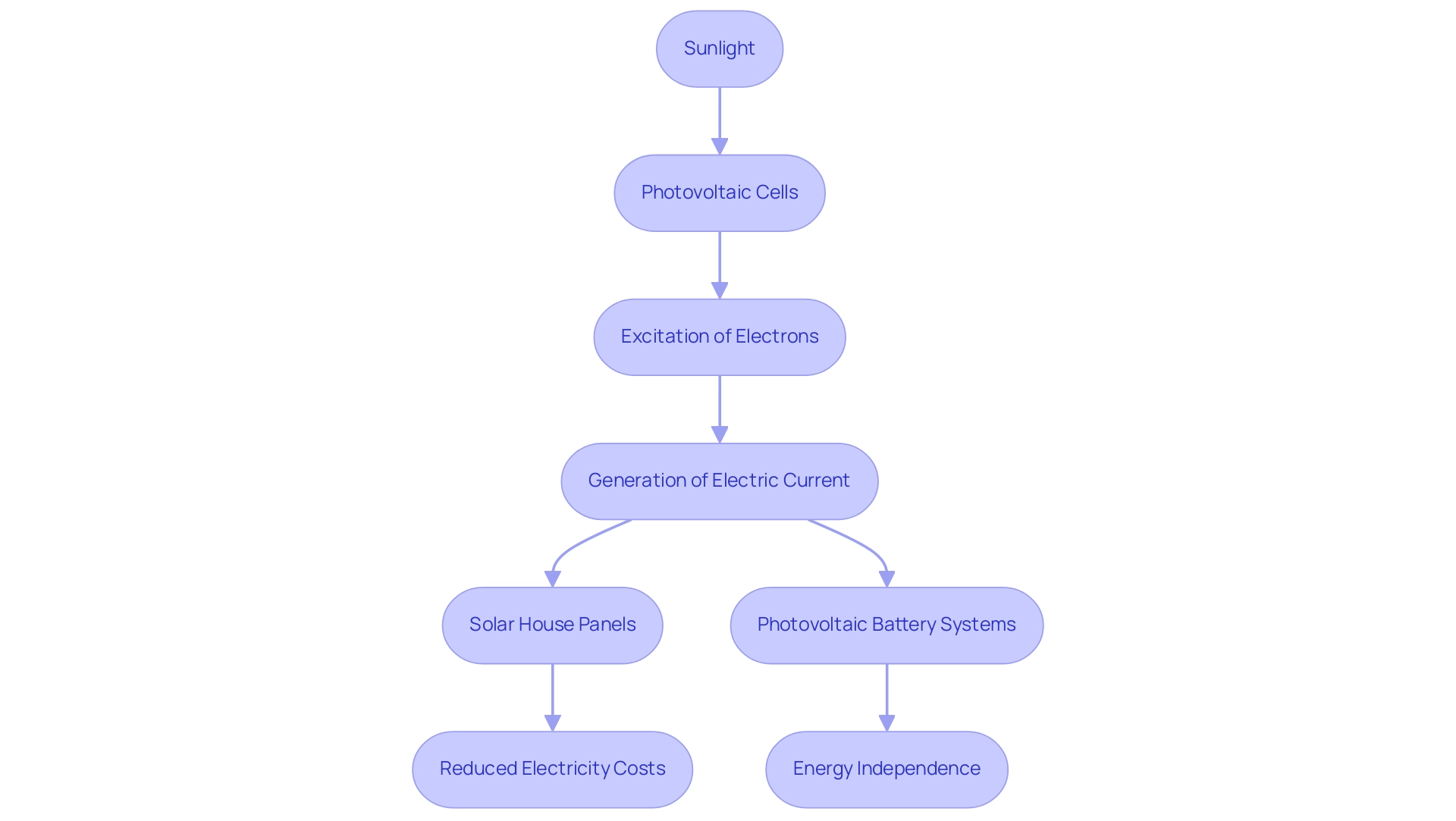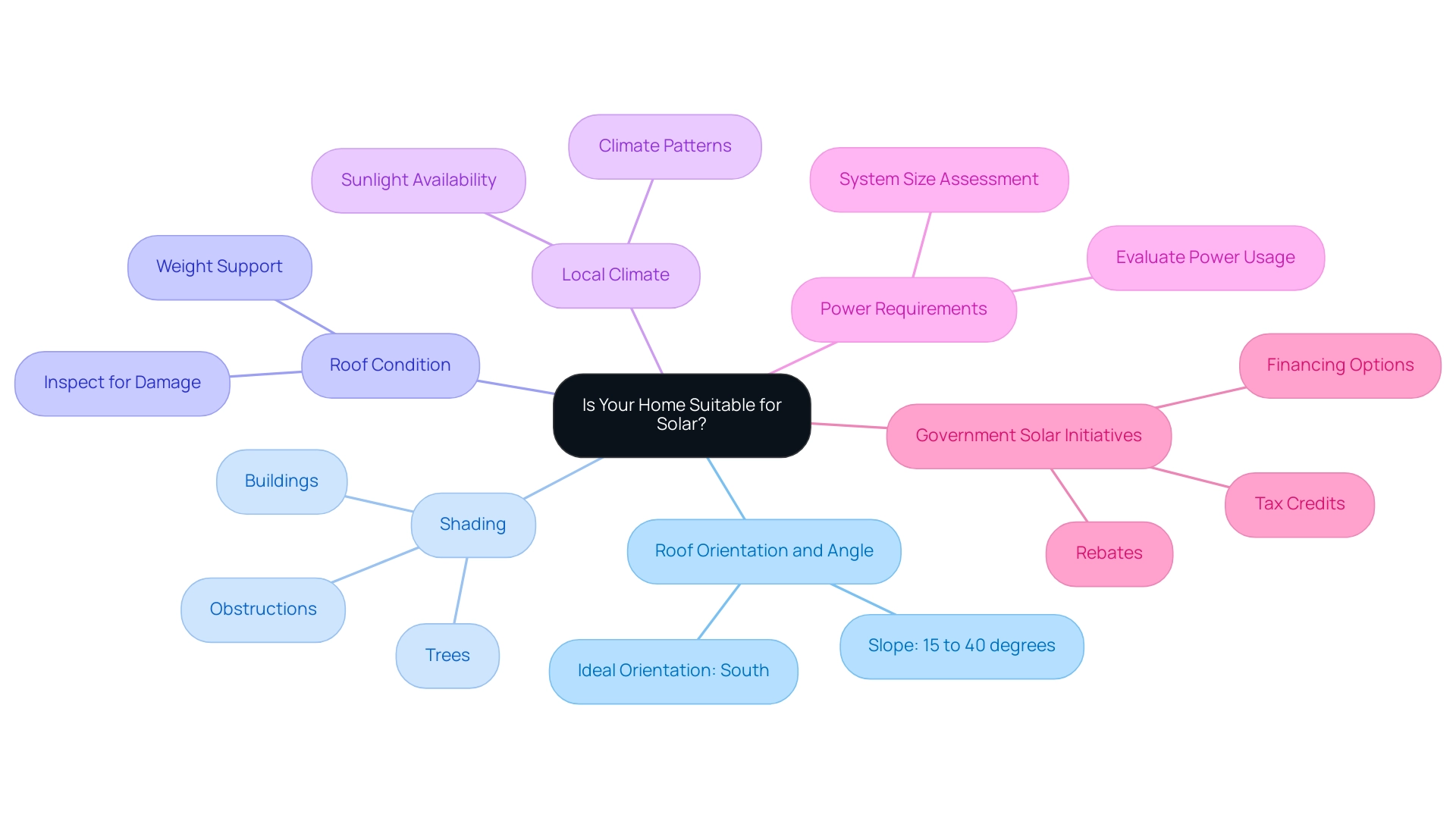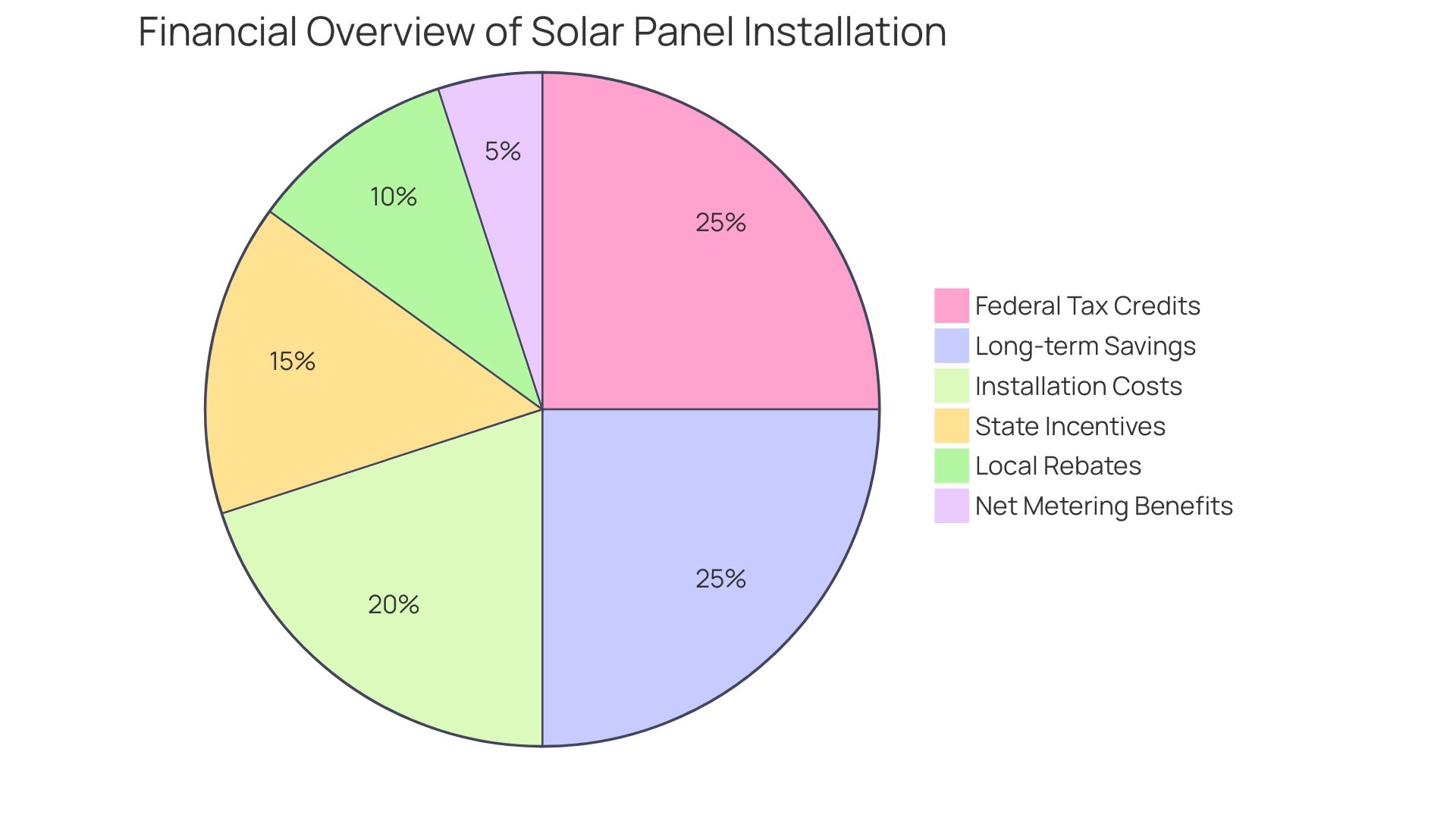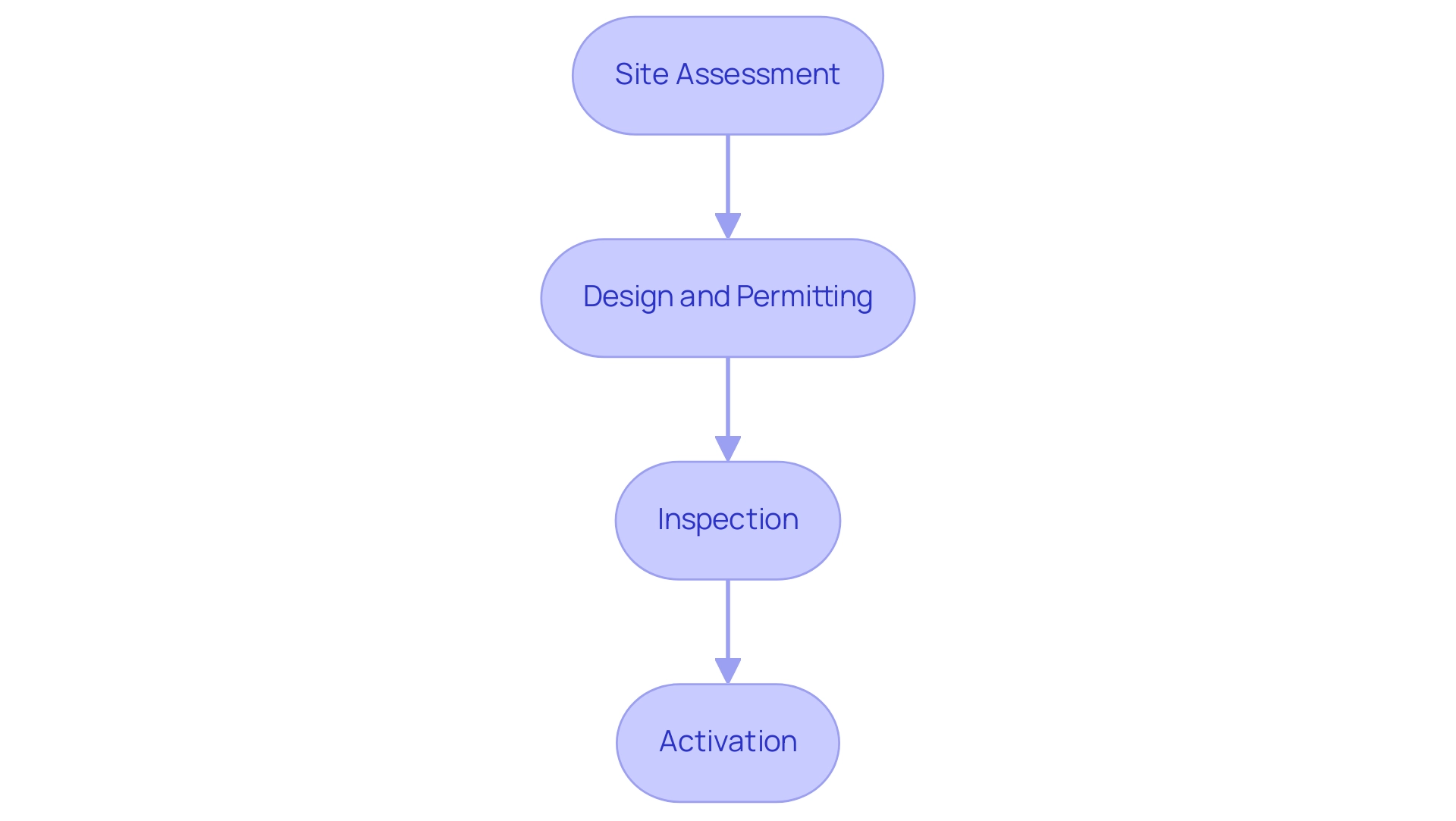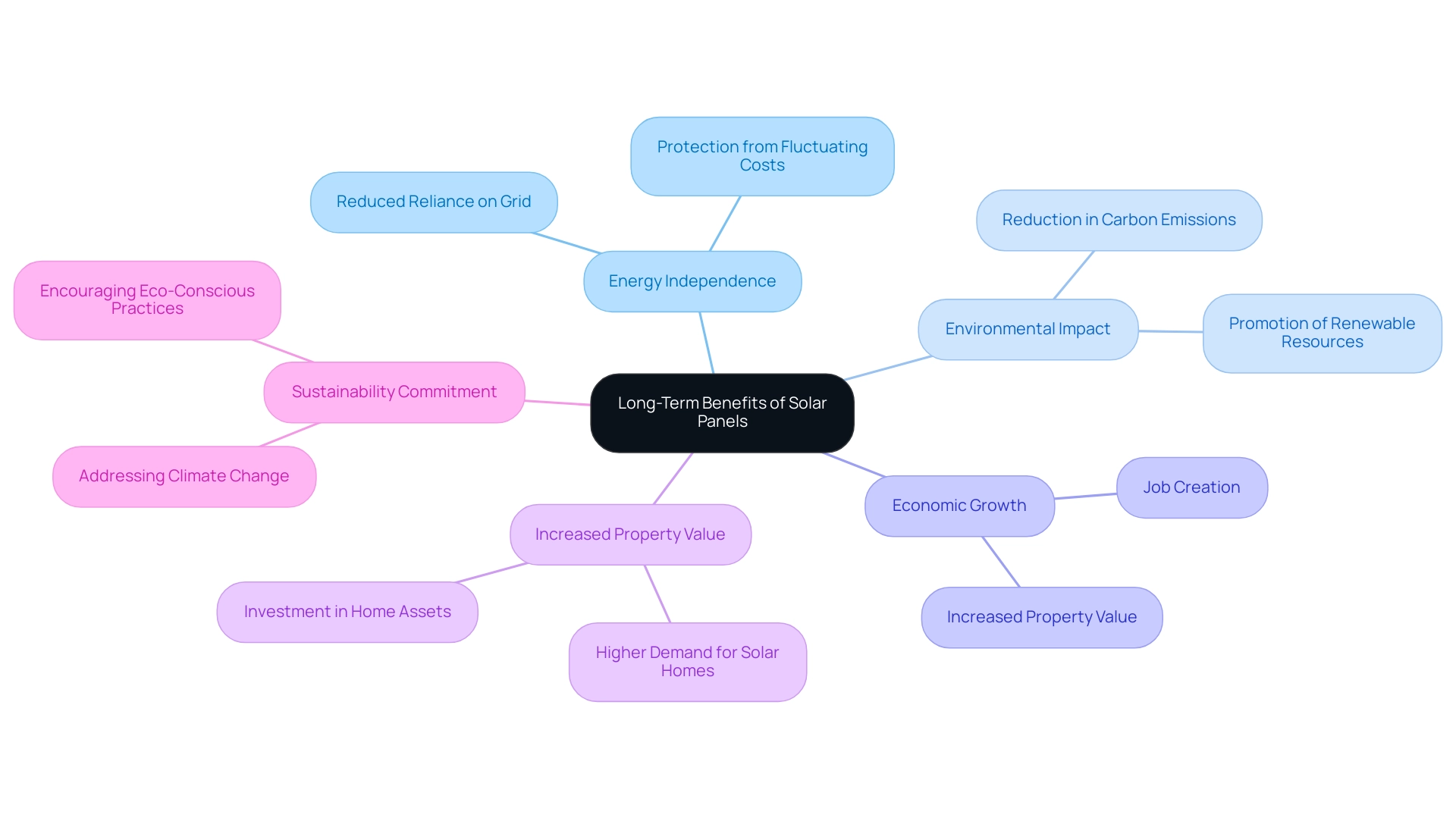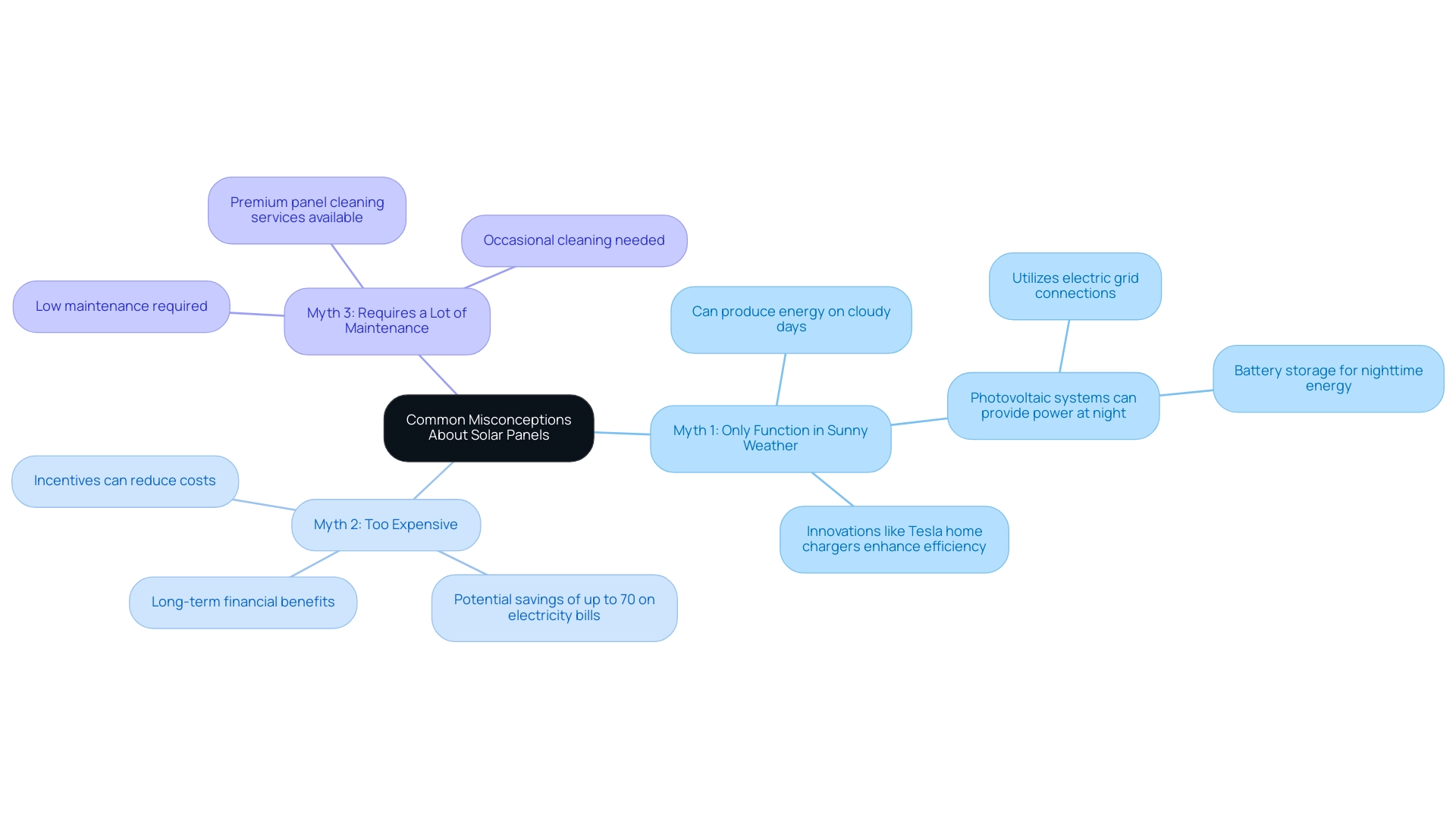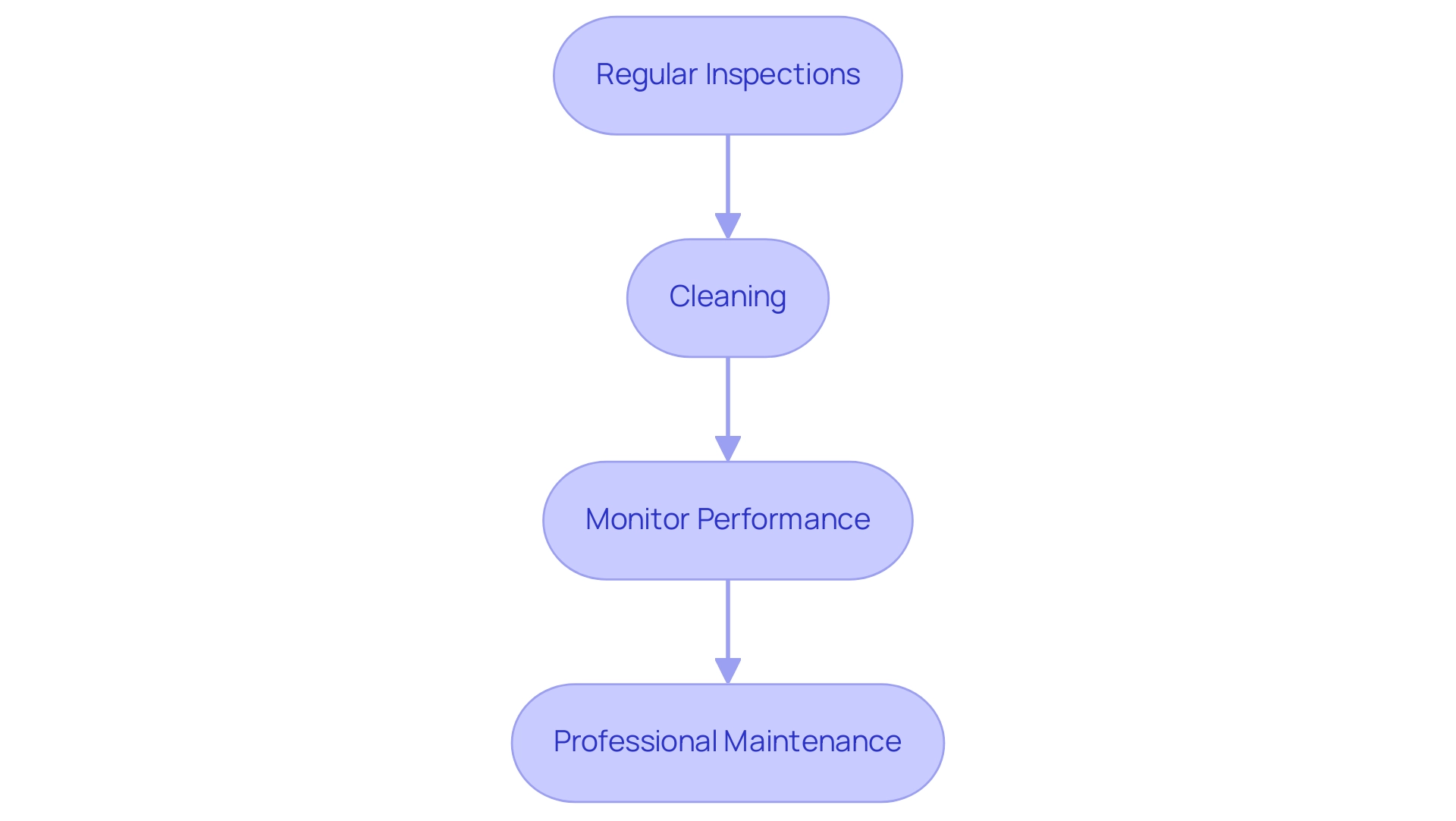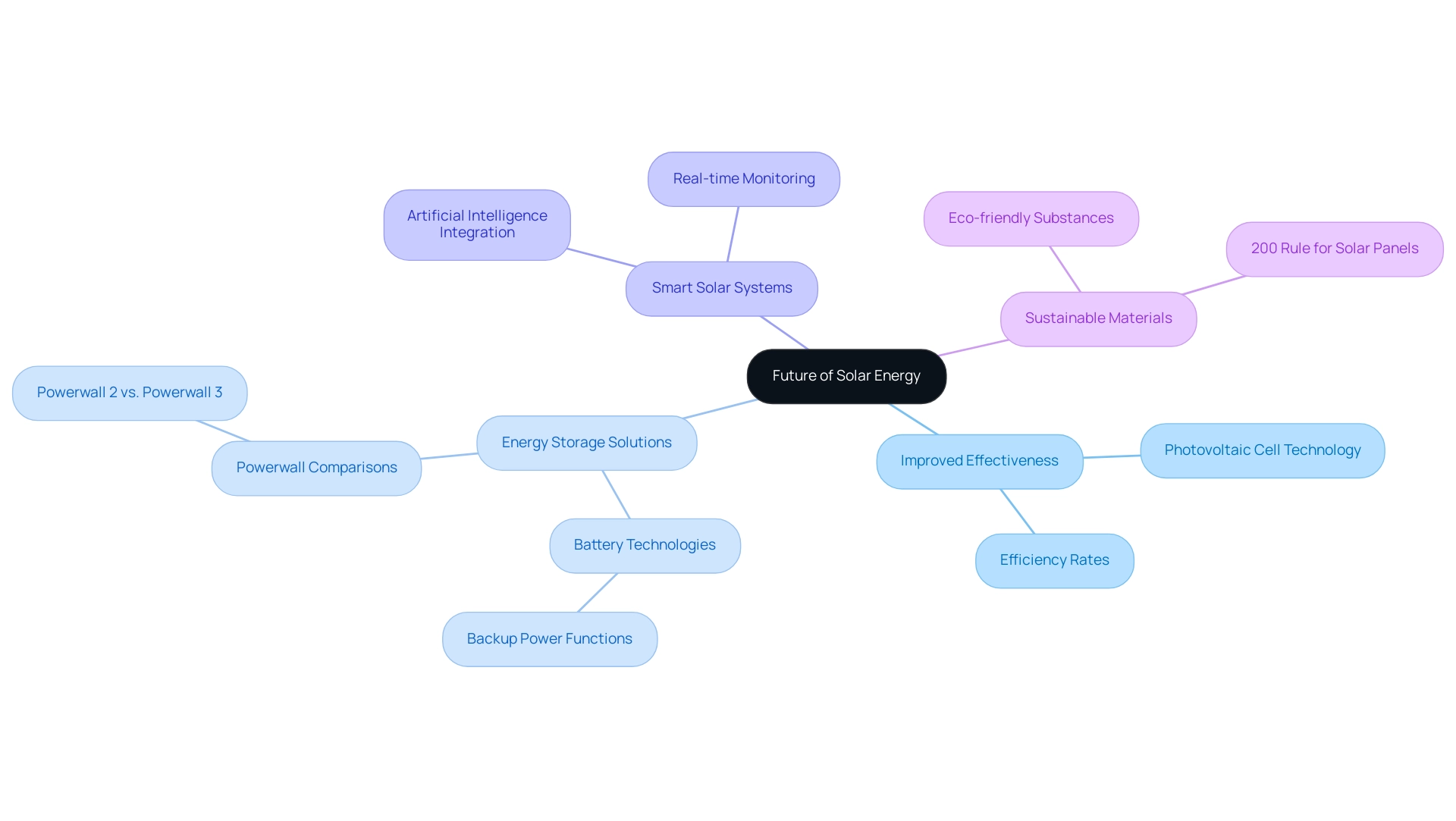Overview
We understand that rising electricity costs can be a significant concern for homeowners. Solar house panel installation offers a sustainable energy solution that not only significantly reduces these costs but also promotes energy independence. With advancements in photovoltaic technology, it’s easier than ever to embrace this eco-friendly option. Financial incentives make solar panels a viable investment, providing an opportunity to alleviate the burden of energy bills while contributing positively to the environment.
Imagine the peace of mind that comes with knowing you’re harnessing the sun’s power to meet your energy needs. Not only do solar panels help lower your utility bills, but they also increase property values and support a cleaner planet for future generations. Together, we can create a brighter, more sustainable future.
If you’ve been contemplating the switch to solar energy, now is the perfect time to explore your options. Let’s work towards achieving energy independence and making a meaningful impact on our environment. Contact us today to receive the guidance and support you deserve on this journey.
Introduction
Are you feeling overwhelmed by rising energy bills? The world is witnessing a remarkable shift towards renewable energy, with solar panels taking center stage in the quest for sustainable solutions. By harnessing the power of sunlight through the photovoltaic effect, these innovative technologies not only provide a clean energy source but also offer significant financial savings and independence from traditional power grids.
We understand that energy independence is a common concern for many homeowners, and as advancements in efficiency and energy storage emerge, solar panels are becoming increasingly accessible and appealing. This article delves into the intricacies of solar panels, from their operational mechanics and installation considerations to the long-term benefits and common misconceptions surrounding them.
Together, let’s explore how solar energy is reshaping the future of power consumption and paving the way for a greener planet. Your journey towards energy independence can start today, and we’re here to support you every step of the way.
Understanding Solar Panels: How They Work and Their Role in Energy Solutions
We understand that rising energy bills can be a significant concern for homeowners. Solar devices operate by harnessing the photovoltaic effect, a process that converts sunlight into electricity, providing a solution that not only addresses these worries but also promotes energy independence. Each module is made up of numerous photovoltaic cells, primarily constructed from semiconductor materials like silicon. When sunlight strikes these cells, it excites electrons, generating an electric current.
This essential process is vital for accessing renewable power sources, greatly decreasing reliance on fossil fuels and minimizing electricity costs. The significance of photovoltaic modules in modern power solutions cannot be overstated. Solar house panels offer a clean and sustainable power source for both residential and commercial applications. By 2025, the most efficient commercially available panels are expected to boast an efficiency rating of approximately 22.8%, with ongoing research pushing the boundaries toward even higher efficiencies.
This advancement is crucial as it enhances the transformation capabilities of photovoltaic technology, making solar house panels a more feasible choice for property owners, even in places like Stockton, California, where cloudy days can impact power generation. Real-world applications of the photovoltaic effect are evident in various renewable power solutions, such as solar house panels. For instance, incorporating solar house panels and photovoltaic battery systems can enhance power savings by up to 90%, allowing homeowners to store surplus power generated during the day for use during peak times or outages. This capability not only encourages autonomy in power sources but also strengthens a more robust power infrastructure, ensuring dependable electricity during unfavorable weather conditions.
Experts highlight the importance of solar house panels in the shift to renewable resources. As emphasized by industry leaders, advancing renewable technology is essential for meeting global climate goals. The International Renewable Energy Agency (IRENA) stresses that to limit global warming to 1.5°C, annual renewable power capacity additions must triple by 2030. This underscores the urgency and significance of embracing renewable power solutions. Additionally, the National Grid predicts a fivefold rise in photovoltaic generation in the UK, from 14 GW to approximately 70 GW by 2030, highlighting the increasing importance of renewable power worldwide.
In conclusion, solar house panels are leading contemporary power solutions, efficiently transforming sunlight into electricity through the photovoltaic effect. With advancements in technology and increasing efficiency, solar house panels represent a critical component in the shift toward sustainable practices. They are an essential investment for eco-conscious homeowners looking to reduce utility costs and enhance their power independence. Together, we can explore the specific energy collector options available from Powercore Electric and receive your complimentary, tailored estimate. Visit our website today to take the first step toward a more sustainable future.
Is Your Home Suitable for Solar? Key Considerations Before Installation
Before embarking on the installation of solar panels, it’s important to evaluate several critical factors to determine your home’s suitability. If you’re an eco-conscious renter in Long Beach seeking eco-friendly energy solutions, we understand that navigating this process can feel overwhelming. Here are some key considerations to help you make an informed decision:
-
Roof Orientation and Angle: Ideally, roofs should face south and have a slope between 15 to 40 degrees. This orientation maximizes sunlight exposure, significantly enhancing energy production.
-
Shading: It’s common to overlook potential shading from trees, buildings, or other obstructions. Even partial shading can drastically reduce the efficiency of photovoltaic systems, so ensuring unobstructed sunlight throughout the day is essential.
-
Roof Condition: A sturdy and well-kept roof is crucial for supporting renewable energy systems. Before installation, inspect your roof for any damage or wear that may require repairs, ensuring it can withstand the additional weight and elements.
-
Local Climate: Areas with plentiful sunlight are more favorable for power generation. Understanding your local climate patterns can assist in assessing the potential effectiveness of solar house panels in your area.
-
Power Requirements: Evaluating your home’s power usage is vital to establish the suitable scale of the photovoltaic system. This assessment will help you choose a system that fulfills your power needs while maximizing savings.
-
Government Solar Initiatives: Explore available government panel programs and incentives that can significantly reduce installation costs. These programs frequently offer tax credits, rebates, and financing alternatives that make renewable power more accessible and financially feasible for renters.
Conducting a thorough evaluation of these factors will provide a clearer understanding of whether your home can benefit from solar house panels as a suitable candidate for renewable power. It’s important to note that a recent study showed that 80% of property owners who chose battery storage did so mainly for backup power features, highlighting the increasing significance of power resilience in today’s energy landscape. As Ben Zientara, a renewable energy policy analyst, notes, ‘38% of all energy companies expect to grow in 2025,’ indicating a positive outlook for the industry.
Additionally, homeowners should be aware of popular incentives for renewable energy, such as statewide tax credits and energy storage rebates, which can significantly enhance the financial viability of installing photovoltaic systems. As you consider energy solutions, together we can ensure a comprehensive evaluation of these key considerations for a successful installation.
Financial Insights: Costs, Savings, and Incentives for Solar Panel Installation
We understand that the cost of installing solar house panels for a standard residential system can feel daunting, typically ranging from $15,000 to $25,000 in 2025. However, this initial investment can be significantly offset by various financial incentives available in California. Homeowners can take advantage of federal tax credits, state incentives, and local rebates, which collectively can reduce the overall cost substantially.
As Emily Walker observes, “The higher the price tag, though, the more you’ll receive as a credit towards your federal tax bill,” making renewable power more accessible and less intimidating.
In terms of long-term savings, property owners can anticipate saving around $50,000 over 25 years on electricity expenses, which emphasizes the economic feasibility of renewable power. Additionally, many states, including California, offer net metering programs. These programs allow property owners to sell surplus energy produced by their photovoltaic systems back to the grid, further increasing their savings and contributing to energy independence.
It’s common to feel uncertain about the payback duration for photovoltaic systems, which usually varies from 5 to 10 years, affected by utility rates and financing choices. Therefore, it is crucial for property owners to perform comprehensive research on available incentives in their region. This is particularly relevant in California, where local utility rates can significantly impact the overall savings. Cash purchases maximize savings, while financing options, such as loans, can provide immediate benefits despite potential interest costs.
By understanding these financial incentives and the average costs associated with solar house panels installation, homeowners can make informed decisions that align with their sustainability goals.
Furthermore, selecting a reputable installer such as Powercore Electric is essential for maximizing the advantages of renewable energy. With over 30 years of experience serving California, Powercore Electric is committed to exceptional service and community engagement. Their in-house team of experts ensures high-quality installations and maintenance, as reflected in customer testimonials praising their efficiency and reliability.
As one satisfied customer stated, “Ryan and his team were great. They were quick, effective, and adhered to the timeline for our energy installation.” This level of service underscores Powercore Electric’s dedication to providing unmatched quality craftsmanship and customer-first service, making them a trusted partner for eco-conscious homeowners. Together, let’s work towards a more sustainable future.
The Installation Journey: What to Expect When Going Solar
The renewable energy installation process is a structured journey that unfolds through several key steps, designed to empower you in your quest for energy independence:
- Site Assessment: We understand that taking the first step can feel daunting. A qualified expert will perform a comprehensive evaluation of your home’s energy potential, considering factors such as roof orientation, shading, and local climate conditions. This evaluation is essential for assessing the viability and effectiveness of solar house panels within a solar system, ensuring that you comprehend your particular power requirements and how to best satisfy them.
- Design and Permitting: Based on the site assessment, custom designs are crafted to enhance power production. During this phase, the necessary permits are secured, ensuring compliance with local regulations and building codes. This step is crucial for aligning the installation with your sustainability goals and maximizing the benefits under the 200% rule, which permits increased power generation. Skilled technicians will then install the solar house panels on your roof and establish the required electrical connections. This step is critical, as it directly impacts the system’s performance and longevity. We encourage you to consider optimal battery options during this phase to enhance power storage efficiency, ensuring that you can utilize sunlight effectively even when it isn’t shining.
- Inspection: Following installation, local authorities conduct an inspection to verify that the system meets all regulatory standards. This step is essential for ensuring safety and compliance with local laws, providing peace of mind about your investment.
- Activation: Once the installation of the solar house panels passes inspection, the system is connected to the grid, enabling you to start generating energy from the sun.
The entire process can span several weeks to months, influenced by factors such as permitting timelines, weather conditions, and the complexity of the installation. According to recent insights from industry professionals, the average time for panel installation in 2025 is expected to remain consistent, with many installations completed within a few weeks once permits are in place.
As the industry evolves, you can anticipate a smoother installation experience, thanks to advancements in technology and streamlined permitting processes. A recent survey highlighted that while challenges like permitting issues persist, there is growing optimism among energy companies about increased sales and customer satisfaction in 2025. This positive outlook reflects a broader trend towards embracing renewable power solutions, aligning with global efforts to enhance sustainability and reduce reliance on fossil fuels.
In fact, the International Renewable Energy Agency (IRENA) states that to stay on a pathway limiting global warming to 1.5°C, annual renewable power capacity additions must grow three times the current level by 2030, underscoring the critical role of photovoltaic energy.
Powercore Electric, with over 30 years of experience serving the California community, is committed to providing high-quality installations and maintenance through its in-house team of experts. This commitment guarantees that you obtain trustworthy and efficient solutions, tackling not only your power requirements but also your worries regarding the sustainability of photovoltaic systems, which mainly comprise low-quality materials such as glass and encounter difficulties in recycling and end-of-life handling. By comprehending residential photovoltaic system dimensions and their advantages, you can make knowledgeable choices that support a sustainable future. Together, we can work towards a greener tomorrow.
Long-Term Benefits of Solar Panels: Energy Independence and Environmental Impact
Investing in solar panels offers a multitude of long-term benefits that extend far beyond immediate energy savings.
We understand that many homeowners are concerned about rising energy bills and the unpredictability of power prices. By generating your own electricity, you can significantly reduce your reliance on the grid. This newfound autonomy not only shields you from fluctuating costs but also positions you favorably against the backdrop of increasing utility expenses. As the renewable capacity in the U.S. is expected to rise from 95 gigawatts (GW) at the close of 2023 to 131 GW by the conclusion of 2024, the journey towards energy independence through solutions like solar house panels is becoming more attainable. This growth underscores the importance of renewable resources, particularly solar house panels, in achieving greater self-sufficiency, especially with government initiatives that support alternative power sources through tax incentives and rebates for installations.
Moreover, solar energy stands out as a clean, renewable resource that plays a crucial role in reducing carbon emissions and our dependence on fossil fuels. By utilizing solar house panels to harness sunlight, you contribute to a significant reduction in your carbon footprint, promoting a healthier environment for all. The renewable energy sector is projected to create 14 million jobs by 2030, highlighting its potential for economic growth while fostering sustainable practices. This job creation serves as a testament to the industry’s role in driving both environmental and economic benefits, further enhanced by the increasing popularity of panel cleaning services that maintain system efficiency.
It’s also worth noting that homes equipped with photovoltaic installations often see a notable increase in property value. This improvement isn’t merely a trend; it reflects a growing awareness of the benefits associated with solar house panels and sunlight power. Properties with photovoltaic panels are increasingly sought after, making them a wise investment for homeowners looking to enhance their asset’s worth. Additionally, incorporating solar house panels alongside photovoltaic battery alternatives allows for effective power storage, further enhancing the appeal of homes equipped with such technology. The availability of Tesla home chargers adds to the convenience and attractiveness of these properties, especially as electric vehicle ownership continues to rise.
Adopting solar house panels is a proactive step towards a sustainable future. It helps address climate change and encourages environmental stewardship, resonating with the values of eco-conscious individuals. As Katherine Antonio, a principal contributor, notes, “Solar is the fastest-growing renewable source because of the larger capacity additions and favorable tax credit policies.” This growth trajectory emphasizes the significance of sunlight power in fostering a sustainable environment, particularly through innovations like solar house panels that offer both aesthetic and functional advantages.
In conclusion, the long-term advantages of photovoltaic systems encompass autonomy in power, ecological impact, increased property value, and a commitment to sustainability. Together, these factors render solar panels a crucial consideration for property owners in 2025 and beyond. Let’s work towards a brighter, more sustainable future together.
Debunking Myths: Common Misconceptions About Solar Panels
Many homeowners may feel uncertain about switching to solar energy due to common misunderstandings surrounding solar technology. Let’s address some of these prevalent myths together:
-
Myth: Solar modules only function in sunny weather.
Fact: It’s a common misconception that solar panels need constant sunshine to generate electricity. In reality, solar panels can produce energy even on cloudy days, achieving up to 25% of their peak output under such conditions. This means that residents can harness renewable resources throughout the year. A recent case study titled “Nighttime Energy Solutions with Photovoltaic Systems” reveals that photovoltaic systems can connect to the electric grid and utilize battery storage to provide power even at night, dispelling the notion that renewable energy is unreliable after sunset. Furthermore, innovations like Tesla home chargers enhance the efficiency of renewable power systems, allowing homeowners to charge electric vehicles using sustainable energy. -
Myth: Solar power is too expensive.
Fact: We understand that the initial cost can be a concern. However, various incentives, including government programs aimed at promoting renewable energy, can significantly reduce installation expenses. Homeowners can save as much as 70% on electricity costs over the lifespan of photovoltaic systems, making solar energy a financially sound choice. As one satisfied customer of Powercore Electric shared, “Switching to solar has not only reduced my bills but also made me feel good about my energy choices,” highlighting the long-term benefits of embracing solar energy. -
Myth: Solar energy systems require a lot of maintenance.
Fact: It’s common to feel apprehensive about maintenance. The good news is that solar arrays are designed to be low-maintenance, typically needing only occasional cleaning to remove dust and debris. This ease of upkeep ensures their long-term effectiveness and reliability. Homeowners can also benefit from premium panel cleaning services to maintain optimal performance.
By understanding these facts, homeowners can feel more confident in their decision to transition to renewable energy. Real-life examples demonstrate the cost-effectiveness of solar energy, especially when considering available incentives. At Powercore Electric, we are committed to helping homeowners make informed choices about sustainable energy solutions, providing personalized service and an in-house team of experts dedicated to high-quality installations and maintenance. Together, we can work towards a brighter, more sustainable future.
Maintaining Your Solar Panels: Best Practices for Longevity and Efficiency
To ensure your photovoltaic systems operate at peak efficiency and enjoy a long lifespan, it’s essential to follow these nurturing maintenance best practices:
- Regular Inspections: We understand that visible damage or debris can be a concern, as these factors can obstruct sunlight. Conducting routine checks is crucial. Research indicates that ongoing oversight can significantly enhance the efficiency of photovoltaic systems. In a growing sector, energy policy analyst Ben Zientara notes that 38% of companies in this field anticipate expansion in 2025, underscoring the importance of maintenance to stay aligned with advancements.
- Cleaning: It’s common to overlook the need for cleanliness, but washing your photovoltaic surfaces at least twice a year is vital. Removing dirt, leaves, and other obstacles can be easily achieved with a soft cloth and mild soap, ensuring you avoid scratches. Efficient cleaning can boost performance output by up to 90%, making it a key aspect of maintenance. Additionally, consider innovative cleaning technologies that reduce water consumption, aligning with our shared commitment to sustainability. Various cleaning services are available, from manual methods to automated systems, each providing unique benefits. Regular cleaning not only enhances the efficiency of solar house panels but also extends their lifespan, ensuring they continue to provide reliable energy.
- Monitor Performance: Keeping a close eye on your system’s power output is essential. Tracking performance allows you to quickly identify any drops in efficiency, which can indicate underlying issues. Homeowners who actively monitor their systems are better positioned to address problems before they escalate. Did you know that integrating solar house panels with a solar battery can enhance savings by up to 90%? This emphasizes the financial advantages of proper maintenance and the use of efficient solutions.
- Professional Maintenance: Scheduling periodic professional inspections is a wise decision to ensure all components are functioning correctly. Engaging experts not only helps in identifying potential issues but also guarantees that your system adheres to the latest maintenance standards. Professional cleaning services can provide specialized equipment and expertise, ensuring thorough cleaning without risking damage to the panels. According to industry insights, 80% of homeowners install battery storage primarily for backup power, highlighting the importance of reliability in power solutions. This trend reflects a growing understanding of the vital role maintenance plays in ensuring power reliability and sustainability.
By adhering to these optimal practices, you can enhance the effectiveness and durability of your photovoltaic system, ensuring it continues to deliver sustainable power for years ahead. The Asia Pacific region is anticipated to dominate the global panel operation and maintenance market from 2025 to 2034, further highlighting the increasing significance of efficient panel upkeep worldwide.
The Future of Solar Energy: Innovations and Trends to Watch
The future of solar energy is exceptionally promising, characterized by several pivotal trends and innovations that are set to reshape the landscape. We understand that many homeowners are concerned about rising energy bills and the impact on their budgets. Fortunately, solar energy offers a path toward greater energy independence and financial relief.
- Improved Effectiveness: Continuous progress in photovoltaic cell technology is producing greater efficiency rates, allowing homeowners to generate more power with solar house panels from smaller setups. This trend is crucial as it permits optimal power production without requiring extensive roof space.
- Energy Storage Solutions: The advancement of battery technologies is transforming how sunlight is stored and used. With 80% of property owners choosing battery storage mainly for backup power functions, these advancements guarantee that solar power can be captured even during non-sunny times, offering reassurance during outages. This highlights the importance of backup power as a key motivator for homeowners investing in battery storage solutions. Notably, the comparative analysis of Powerwall 2 vs. Powerwall 3 reveals significant advancements in storage efficiency and integration with home power systems, making these options increasingly appealing.
- Smart Solar Systems: The incorporation of artificial intelligence and intelligent technology into power systems is improving management. These systems enable real-time observation and enhancement of power consumption, ensuring that residents can optimize their renewable investment while reducing waste. This is especially pertinent for eco-aware residents seeking to make informed choices regarding their power solutions.
- Sustainable Materials: Research into eco-friendly substances for photovoltaic systems is gaining momentum, significantly reducing the environmental impact of solar energy production. This shift not only aligns with sustainability goals but also attracts eco-conscious individuals who are looking to make responsible choices, including the use of solar house panels. Comprehending the advantages of solar house panels and their dimensions under the 200% rule can further assist property owners in choosing the appropriate systems for their requirements.
As the renewable sector advances, keeping updated on these trends will enable homeowners to make strategic choices regarding their power solutions. With 78% of installers expecting a rise in renewable sales in 2025, the momentum for sustainable power is undeniable. Carolyn Amon, a research leader in power, utilities, and renewables, notes that “demand growth is a rising tide that lifts all boats, and it especially lifted renewable ones in 2024.”
Moreover, as supply chain disruptions diminish and U.S. manufacturing increases, the price of photovoltaic modules is anticipated to decrease, making renewable power more attainable than ever. Monitoring these advancements will guarantee that property owners can successfully shift to sustainable power methods while reaping the advantages of innovative renewable technologies.
Furthermore, Powercore Electric provides a variety of energy solutions that correspond with these trends, offering residents options that enhance efficiency and sustainability. Together, we can explore specific case studies from Powercore Electric that illustrate how homeowners have successfully utilized solar house panels under the 200% rule, showcasing the tangible benefits of investing in solar energy. Let’s work towards a sustainable future together.
Conclusion
Investing in solar panels presents a transformative opportunity for energy independence and sustainable living, making it an essential consideration for homeowners today. We understand that rising energy bills can be a significant concern, and throughout this article, we explored the operational mechanics of solar panels, the importance of proper installation, and the financial incentives available. The numerous benefits—such as significant long-term savings on electricity bills, increased property value, and a reduced carbon footprint—clearly illustrate the advantages of adopting solar energy solutions.
Moreover, it’s common to feel uncertain about solar technology, but we addressed common misconceptions, emphasizing that solar panels can generate energy even in less-than-ideal weather conditions and that maintenance requirements are minimal. This understanding empowers you to make informed decisions, free from unfounded fears.
As advancements in technology continue to enhance solar panel efficiency and energy storage solutions, the future of solar energy looks exceptionally bright. We encourage you to consider not only the immediate benefits of solar energy but also its vital role in fostering environmental sustainability and resilience against rising energy costs. Embracing solar energy today is not just an investment in lower utility bills; it is a heartfelt commitment to a cleaner, greener future for generations to come. Together, let’s work towards a sustainable tomorrow.



